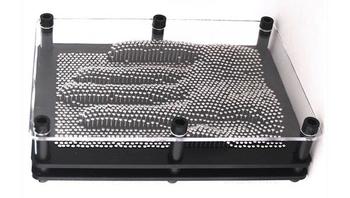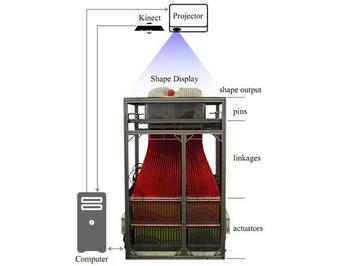Researchers at the Massachusetts Institute of Technology have designed a Tangible User Interface (TUI) system which allows you to touch, manipulate and interact with remote objects. Working in the MIT Media Lab, the Tangible Media Group beavers away, trying to imagine and create the future of computer interfaces. What the team has come up with in this instance is interesting and fantastically mesmerising to watch in action. However it is hard to imagine a practical use of the inFORM UI. I recommend you take a look at the video below…
The system uses the common-or-garden Kinect from Microsoft as a key component on one side of the divide. Remotely there is a piece of equipment, which can most simply be described as a computer controlled pin screen, like you see in gadget and executive toy shops. When a user on the Kinect side of the communication loop interacts with the gesture controller a 30x30 grid of actuated pins rises and falls remotely - to replicate what is seen by the Kinect. A user is free to use their hands and other objects to work with the TUI.
Remote controlled pin screen?
The Tangible Media Group feels that technology has become unbalanced in that designers can create amazing graphics on screen but there is a distinct lack of tactility. One of the designers of inFORM, Daniel Leithinger, told Fast Company that “Right now, the things designers can create with graphics are more powerful and flexible than in hardware.” He came to a startling conclusion, “The result is our gadgets have been consumed by the screen and become indistinguishable black rectangles with barely any physical controls. That's why BlackBerry is dying.”
If you are wondering about the construction of the inFORM, take a look at the diagram below. We are informed that the ‘pins’ are 9.5mm2 polystyrene rods, each of which can extend up to 10cm from the surface powered by the 30x30 array of actuators. Each ‘pin’ is capable of hefting a weight of 100g on its own. In tests the researchers managed to launch a 7g ball approximately 8cm above the maximum pin height of the surface.
Remotely touching your partner
In some sickly sweet but related news a Kickstarter project has on offer a wrist band which allows you to remotely touch your partner. The TapTap by Woodenshark joins you and a partner at the wrist. This communication wristband “connects you and your beloved one as if you never left each other,” says the Kickstarter promotional page. The schmaltz continues; “Your beloved is the only one who will feel that you touched your wristband. No matter how far away you are from each other, it feels like you just touched his hand. Two TapTap wristbands are connected only to each other, same as you two are.”
However Woodenshark don’t want to limit the appeal of the TapTap to the lovesick and suggests that its accelerometer and gyroscope could be used by developers to make other useful smartphone accessories such as an alarm system which sends an SMS with location data if a pre-defined series of taps and gestures is made by the wearer. A pair of TapTaps can be acquired as a reward for $130 of backing.










